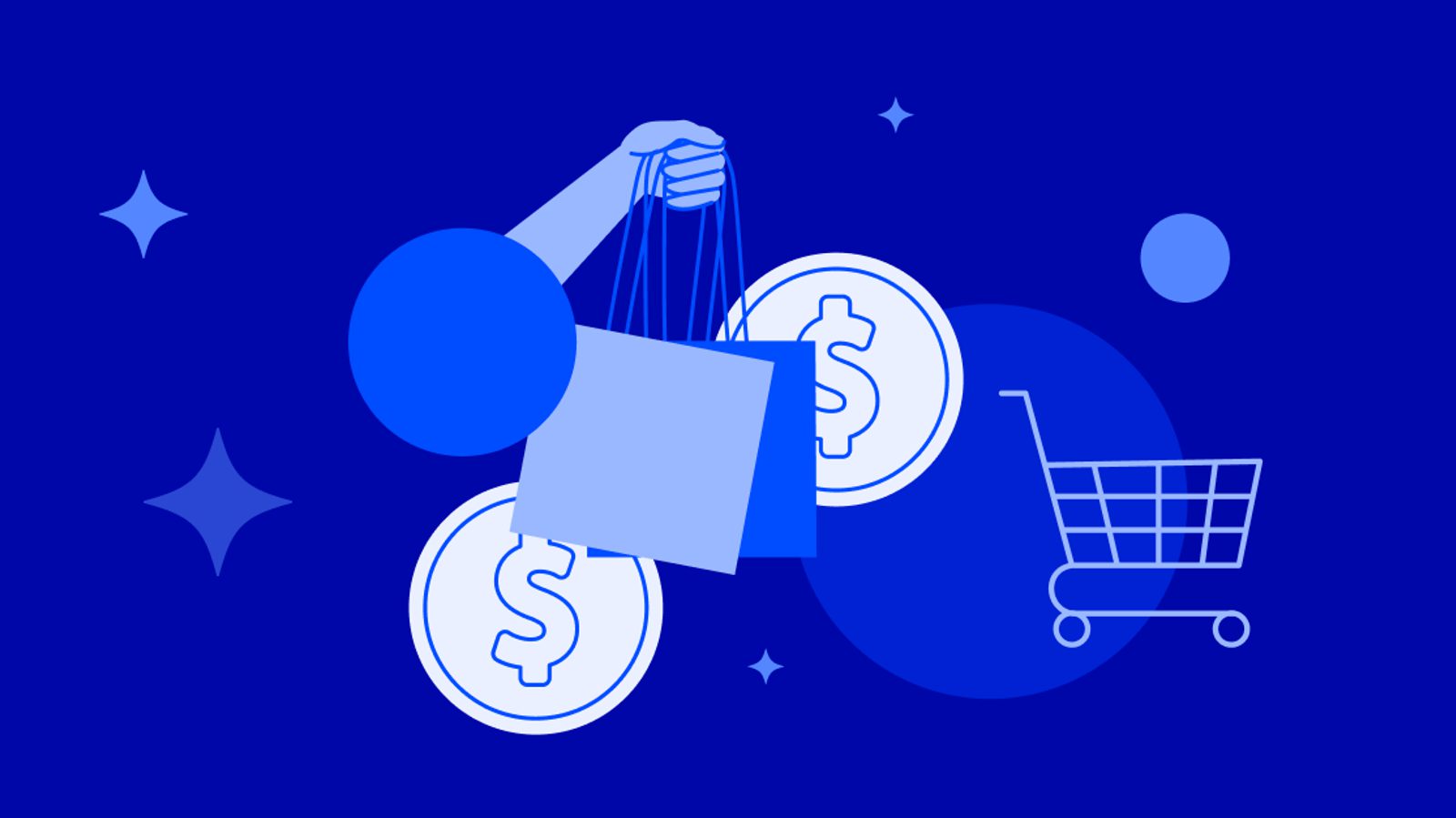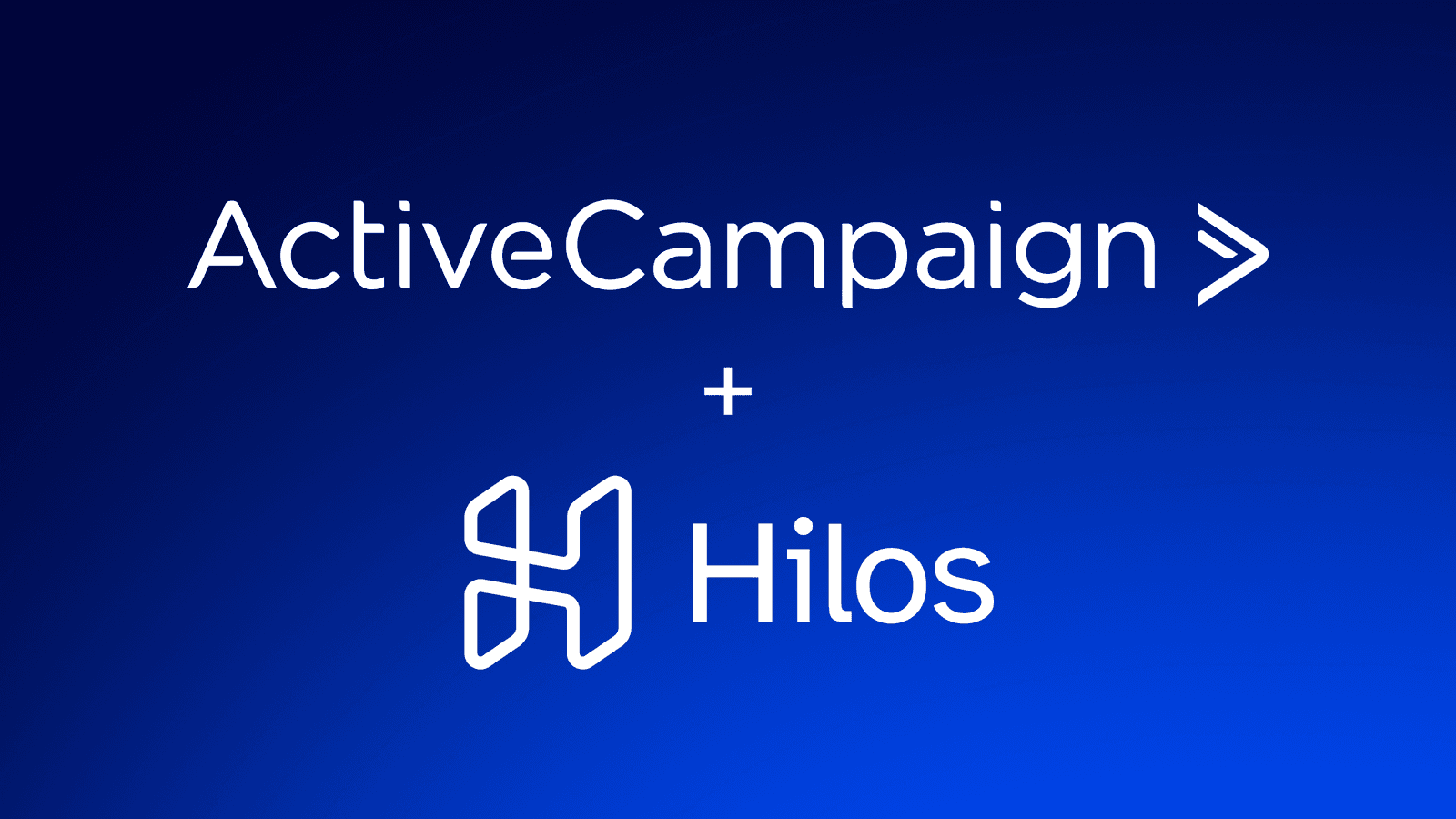Black Friday isn’t just a shopping day—it’s one of the biggest opportunities of the year for e-commerce businesses. With nearly every store offering steep discounts and exclusive deals, standing out from the crowd is essential. Simply throwing a sale won’t cut it; you need a Black Friday email marketing campaign that grabs attention and drives action.
Now, success means going beyond just big discounts. Your Black Friday marketing should leverage effective marketing strategies, eye-catching creatives, and personalized targeting to truly make an impact. The right approach can turn inboxes into high-converting sales channels and make this holiday season your most profitable yet.
Ready to create a Black Friday campaign that rises above the noise? Let’s dive into the strategies that will get you there.
Black Friday campaigns that stand out
More and more businesses are selling on social media. According to Statista, in 2021, 8 in 10 US businesses anticipated using social media marketing to boost Black Friday sales.
Check out the following examples of excellent Black Friday social media campaigns.
Use a sense of urgency: Thinkific on Instagram
Thinkific is a platform that helps you create and sell online courses. Their social media posts set a fantastic example of promoting their Black Friday offers in advance and letting the urgency build up as the sale gets closer to ending.
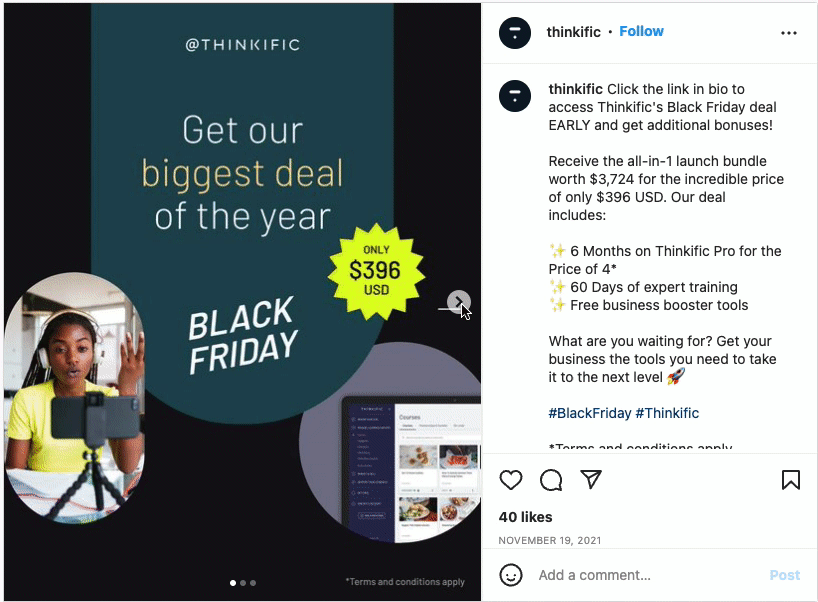
They announce their biggest deal of the year early with a launch bundle that highlights the value and savings. Also, note how they write the caption. They use short sentences, line breaks, and emoji bullets to make the offer easy to skim and understand.

Their second promotion ideas post is on Black Friday. They push the urgency with a CTA, letting people know the offer is almost gone. The copy here is shorter and gets to the point. This is aimed at potential customers and those who already know the product and only need to know what the offer entails.
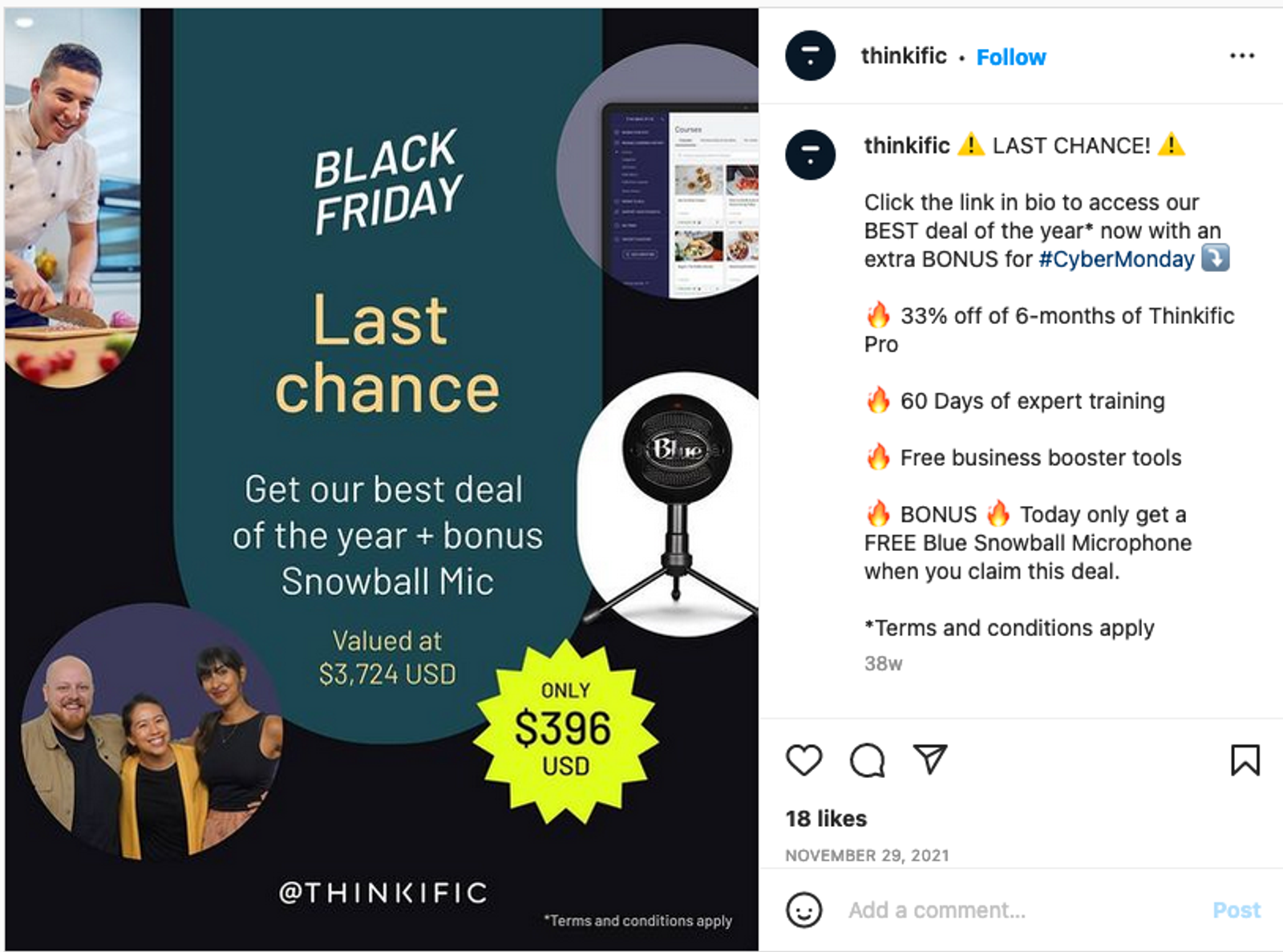
Then, they extend their Black Friday offer on Cyber Monday but set a hard deadline with a bonus to entice any remaining prospects holding out for Cyber Monday. Last-minute deadline bonuses can greatly motivate extra sales in the home stretch.
Leverage user-generated content: Whole30 on Facebook
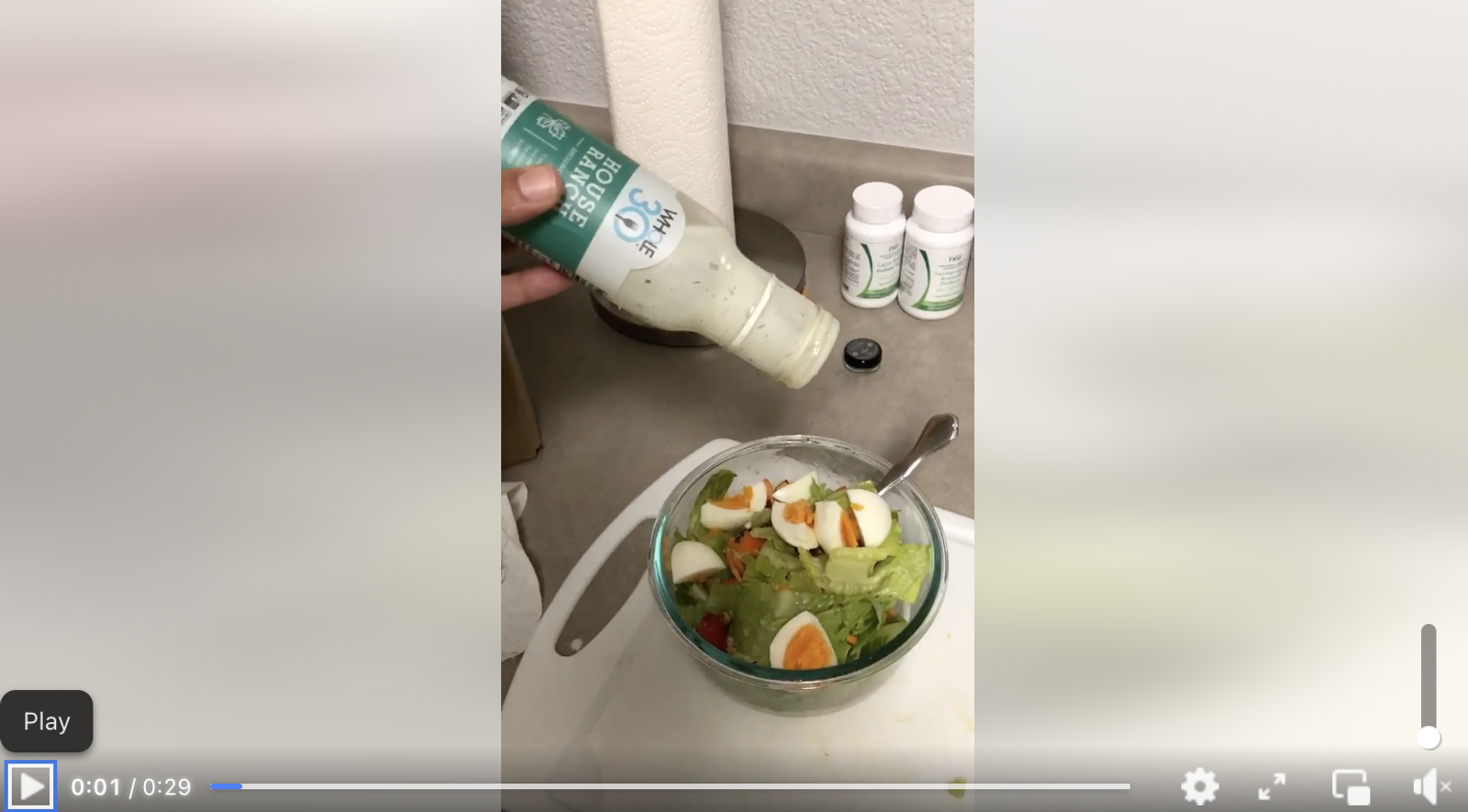
ActiveCampaign customer Whole30 is a diet program that helps people switch to healthier diets in 30 days. In one of their social posts during Black Friday, they shared a customer video highlighting a sale of their dressing.

This is a great social media ad because of a few things:
- It shows that real people love their products.
- The copy highlights that these rarely go on sale.
- It promotes a bonus item for spending $60 or more.
These are great tactics to try if you have a strong community and fans who love your product.
Get creative with your target market: Code Camp on Facebook

Another ActiveCampaign customer, Code Camp, is a holiday and after-school program for kids to get creative with technology. While their Black Friday offer is simple, the creative is what makes them stand out. Lots of bold colors and graphics highlight the activities in their programs.
In addition, their target market is kids, so they made that the largest element. And they're looking directly at you! So, if you're a parent looking to save on an after-school program, you'd definitely want to check this out.
Presell your sale: Hipcooks on Facebook
Build hype around your Black Friday deals by getting people to sign up for your newsletter. Hipcooks (an ActiveCampaign user) told their followers they'd share their Black Friday deals in their email newsletter.
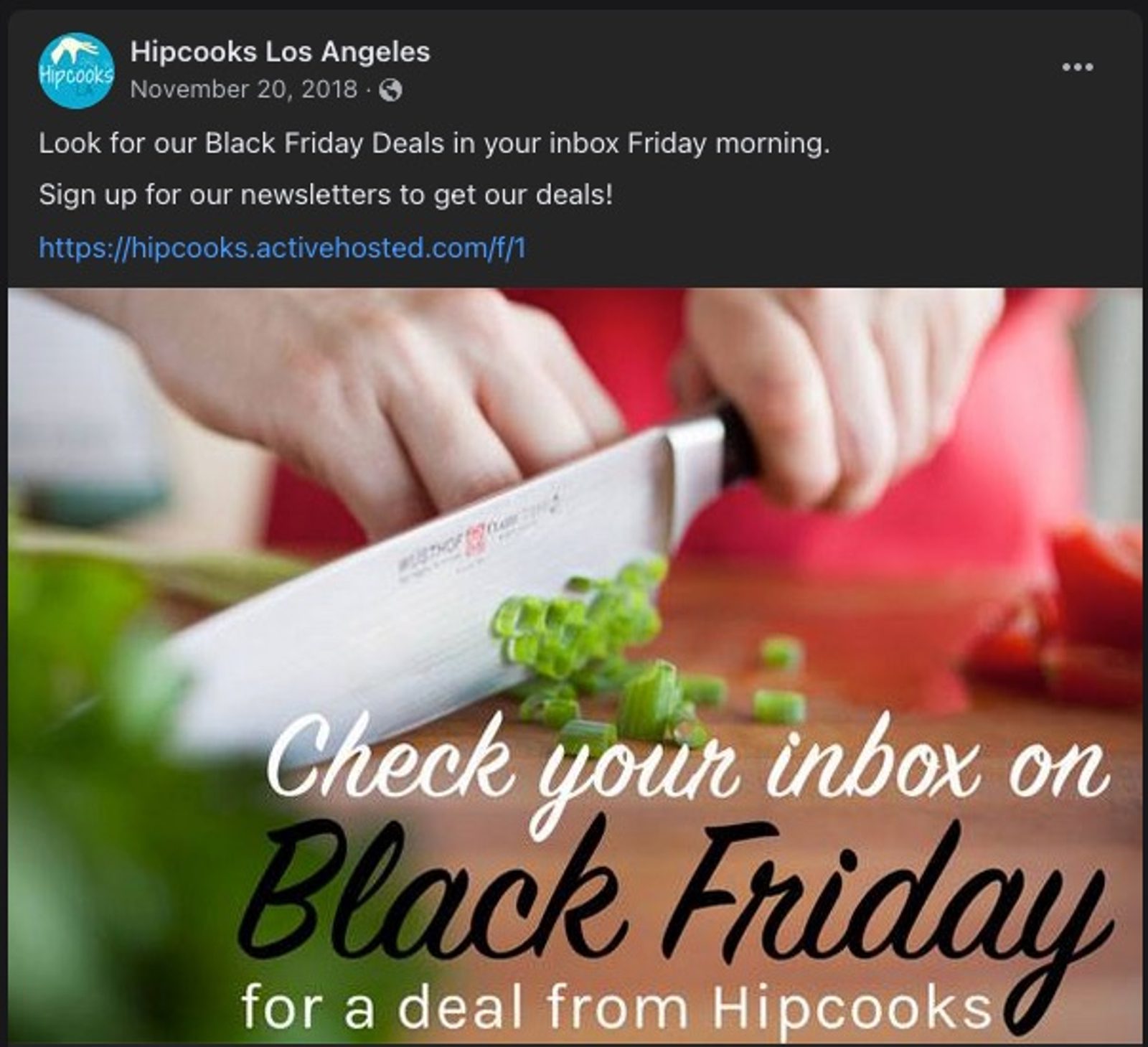
This is a great way to get people on your email list to buy as soon as your sale goes live. You can also use these ads to generate leads by offering early access to upcoming deals in exchange for their email address.
Black Friday email campaign marketing ideas that grab attention
Email strategy is at the core of many great marketing campaigns because it remains a highly effective channel. According to Shopify, email marketing efforts have the highest average order conversion rate compared to channels like direct mail, Google search, and social media.
Use behavioral personalization: Dick's
This Black Friday deals email from Dick's Sporting Goods not only promotes their biggest sale of the year but also does a great job of personalization. In this promotional email, their target audience is golfers, so they made sure to include golf bags and a golf category to increase relevancy.
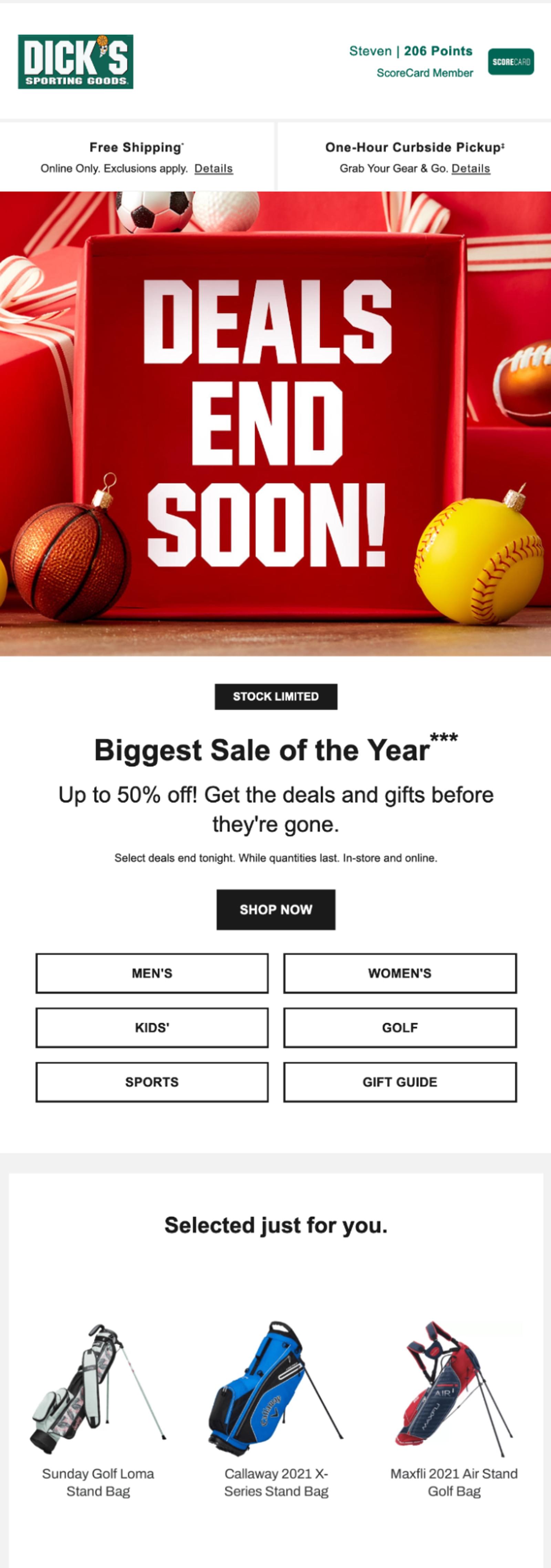
You can implement this with customer segmentation. Tag loyal customers based on their purchase history and use conditional content to personalize product recommendations.
Put your product front and center: Knockaround
Knockaround features a fantastic shot of one of their sunglasses in addition to beautiful graphics and a clear offer. This makes for a much more engaging visual when compared to seeing a shot of the sunglasses on their own.
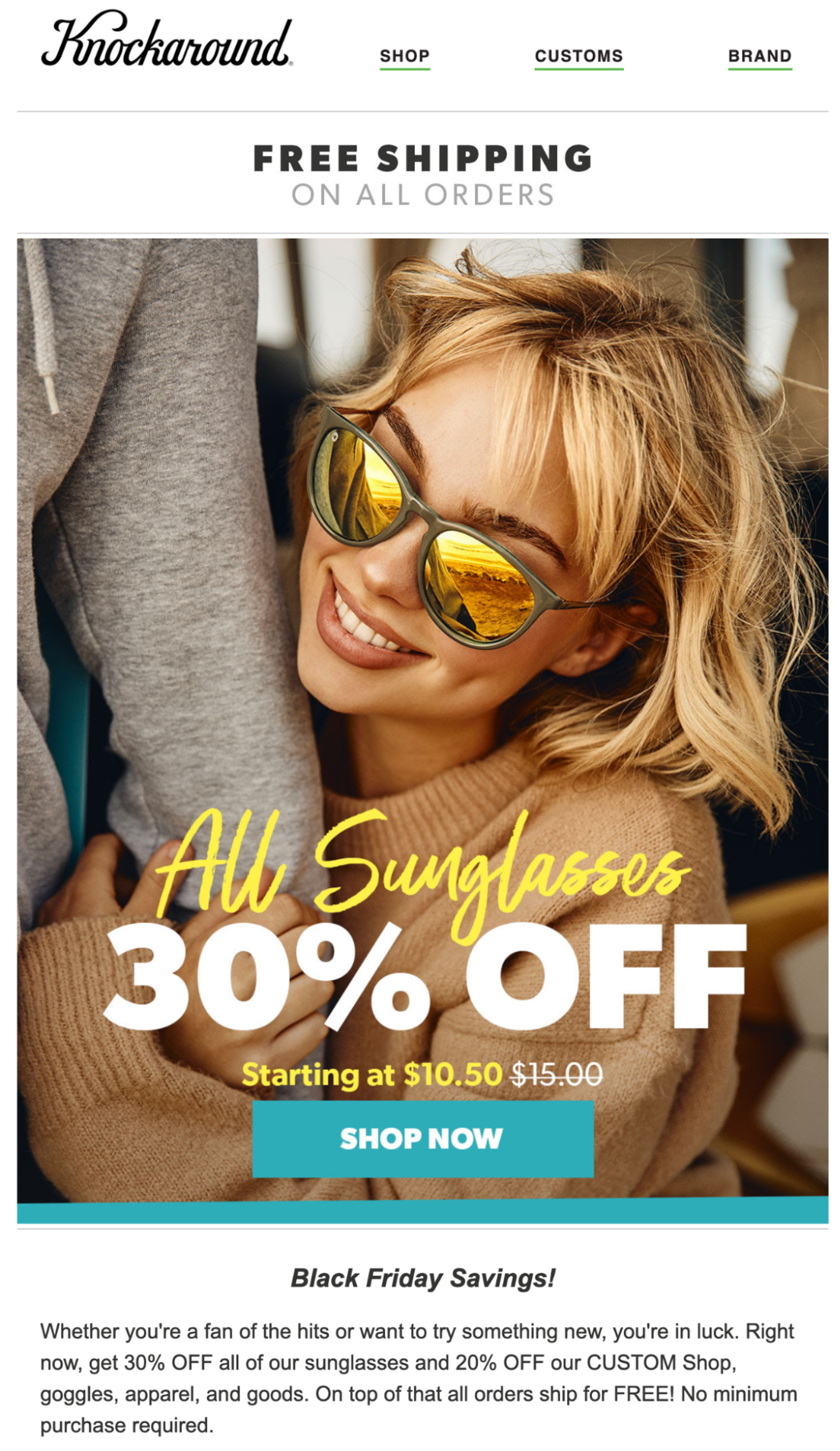
Take a different approach: Thrive Themes
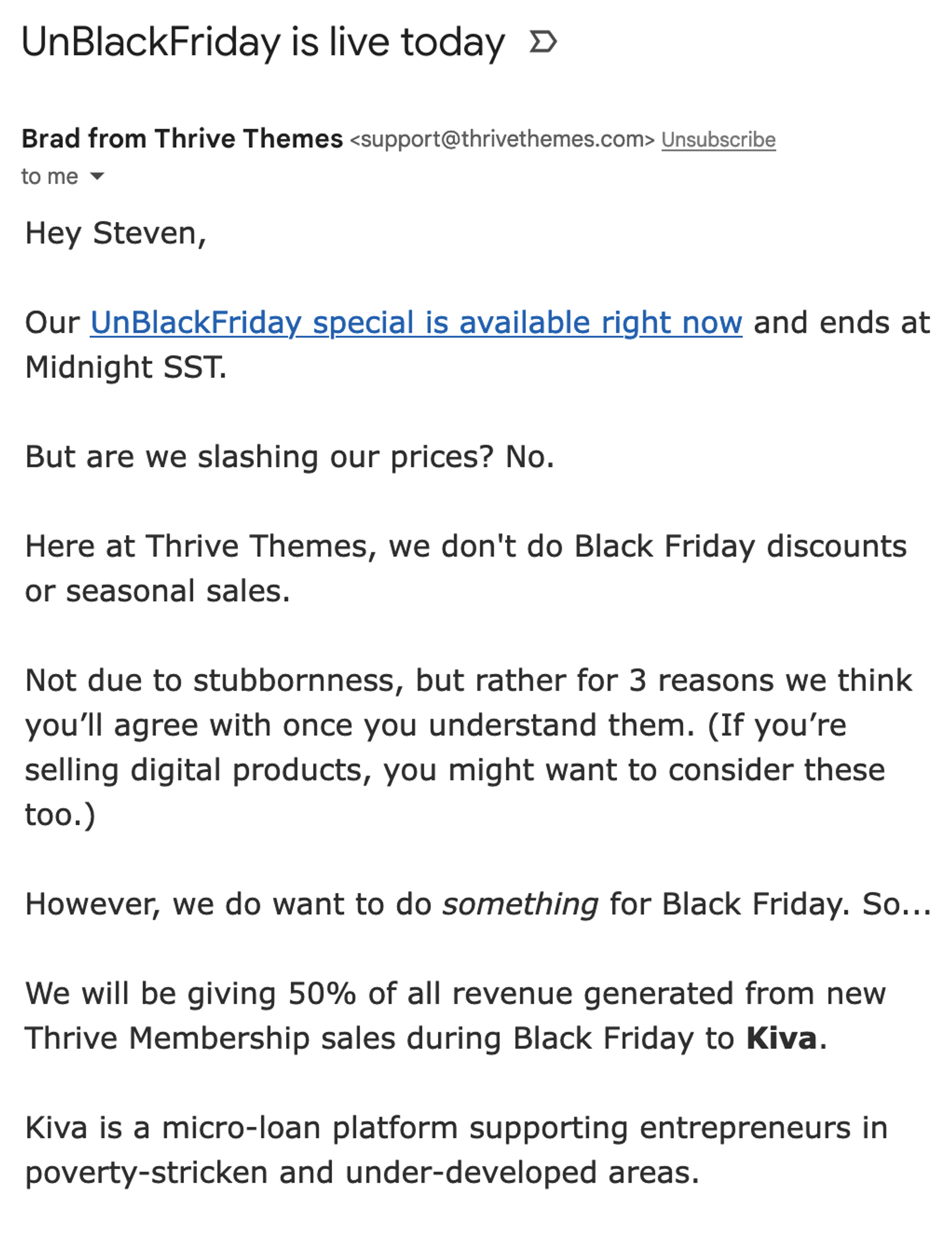
Maybe Black Friday sales go against your business model. In this example, ActiveCampaign customer Thrive Themes shares their “UnBlackFriday” special.
Instead of exclusive discounts during Black Friday, they give to Kiva, a micro-loan platform that supports entrepreneurs in poverty-stricken and under-developed areas.
If you never offer discounts, this is a great way to leverage the holiday shopping season while supporting a cause you believe in.
Use GIFs to capture attention
GIFs are a great way to add dynamic imagery to your emails. They grab a user's attention and give them something to focus on for a few seconds. They can be tricky to pull off, though.
Are your email and social channels optimized?
As you can see, these brands didn't just share their biggest sales. Their beautiful designs and creative copywriting make people pay attention. And if you combine that with smart targeting, relevant personalization, and knowing your audience, you can stand to make huge gains on Black Friday every year.
As we approach another Black Friday, this year's holiday sale will come with its challenges for brands to prepare for.
How will global economic uncertainty affect future Cyber Week sales? What influences consumer behavior in 2024? What are the dos and don'ts for a successful Black Friday? How can businesses demonstrate situational awareness and address buyers' changing needs?
To answer these questions, let's look at some fresh Black Friday statistics and turn them into actionable insights. You'll learn to prepare for the biggest shopping event of the year and delight your customers.
Black Friday Facts and Insights
Black Friday Fact 1: 59% of customers start their holiday shopping in August or September
Early shopping seems to have become the new norm. 83% of customers are fed up with the Christmas shopping frenzy and prefer to buy in a more relaxed fashion. 19% start shopping in August, 18% in September, 22% in October, and 24% in November (but before Cyber Week).
For most consumers, Black Friday has lost its appeal and become a regular chaotic sale. Just 9.6% of US-based buyers wait for Black Friday to start their holiday shopping.
There are a few reasons for this:
- Major retailers rarely offer generous online deals; some even raise their normal prices during Black Friday.
- The influx of holiday shoppers is responsible for notorious shipping delays and website crashes.
- Customers have fewer choices—just two-thirds of US businesses offer Black Friday deals, with only specific product categories being discounted.
- Product availability is often an issue during Cyber Week, leading to customer frustration.
Customers get more vigilant during this time and are quick to call out brands for artificially increasing prices ahead of Black Friday.

What this means: Account for early birds—start your promotions early and keep them around for longer. This means more build-up, exclusive deals, nurturing email campaigns, and a lot of holiday talk beginning in September. Make sure that your Black Friday sale includes genuine special discounts. Customers do their research, see through fake discount codes, and walk away if they realize that the seller is manipulating them.
Black Friday Fact 2: Half of consumers use smartphones to check out Cyber Week deals and place orders
Customers want to browse and shop on the go with ease. 57% of online shoppers use their mobile phones to discover and compare Black Friday deals, and 39.7% complete online purchases from their mobile devices.
As a result, customers expect frictionless buying experiences—intuitive and responsive websites, skimmable emails, quick signup forms, a straightforward checkout process, and so on. They won't spend too much time on a clunky, dated online shop because they know another Black Friday offer is just around the corner.

What this means: Make it easy to buy from you. Test your online store's mobile-friendliness and usability to ensure it works great on any device and is accessible to users with different needs and backgrounds. Create smooth experiences for your audience using email marketing automation and CRM tools made specifically for e-commerce businesses.
Black Friday Fact 3: 66% of customers care about sustainability when shopping
Buyers are trying to shop more consciously and sustainably, according to McKinsey. 34% of consumers are willing to pay more for ethically and sustainably produced items.
Black Friday, once clearly a feast of overconsumption, has slowly become a chance for green brands to enter the spotlight. The younger audience is more selective when shopping and eager to see more sustainability initiatives from their favorite brands.
What this means: Think of ways to make your Black Friday sale more eco-friendly, and let your customers know that your business cares for people and the planet. Offer recyclable packaging, send educational emails with eco-friendly tips, and incentivize in-store pick-ups.
Black Friday Fact 4: Raising social or environmental awareness can increase your sales by 5 times
Patagonia reached a record-breaking $10 million in sales right after announcing that it'd give 100% of its global retail and online Black Friday sales to grassroots nonprofit organizations fighting the environmental crisis and protecting nature.
The company expected to make $2 million in retail sales but made 5 times that due to its bold environmental pledge. Patagonia became a powerful example of how a big brand can stand up for its beliefs and values and “earn more by earning less.”On another Black Friday, Patagonia even explicitly asked its customers not to buy any new products, which boosted the customers' devotion.
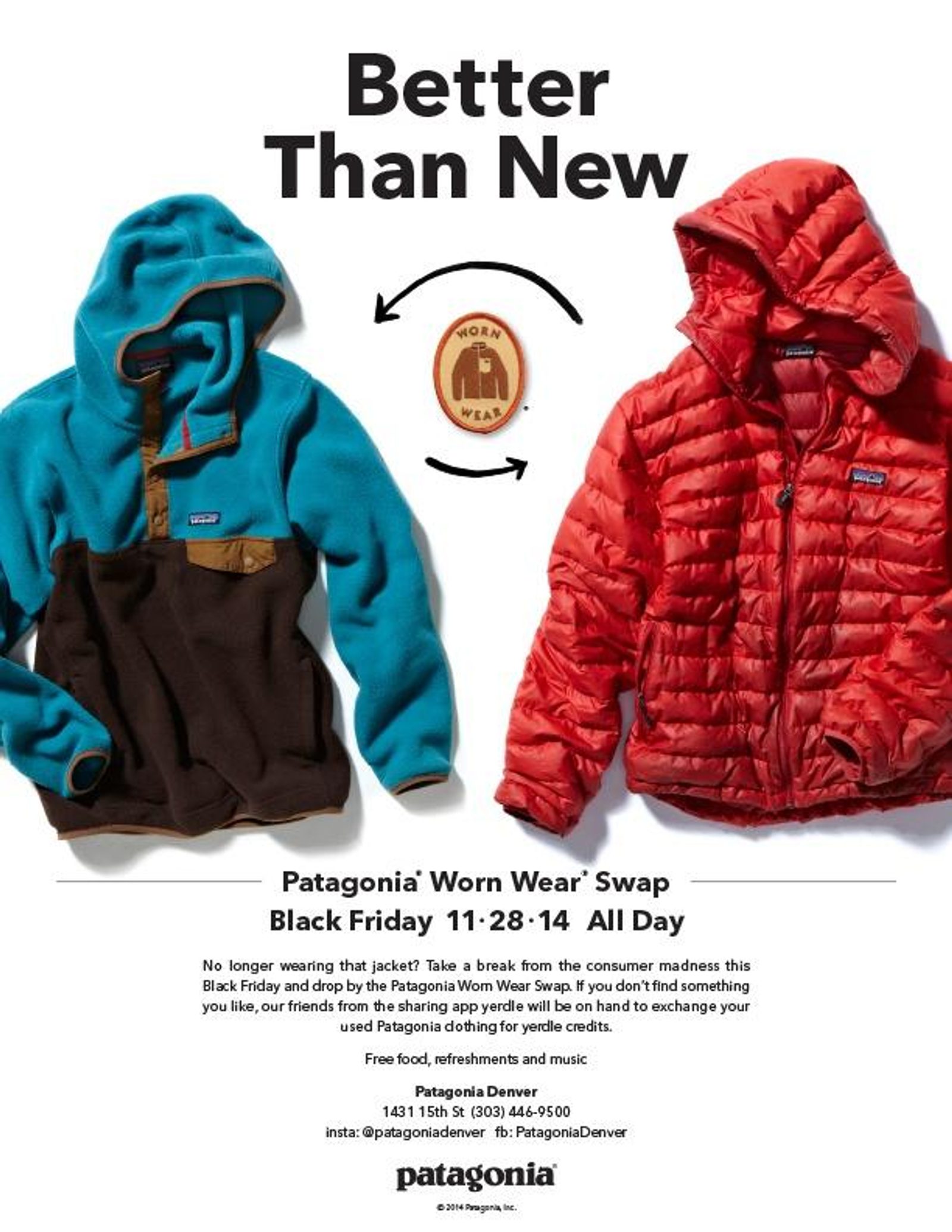
What this means: Social impact sets certain brands apart and makes them more desirable and respected long-term. Prioritize a sustainable approach over quick wins, and make your Black Friday sale more meaningful for your audience. Create highly personalized, nurturing emails to let your customers know more about your brand's mission.
Black Friday Fact 5: 88% of consumers like and support authentic, relatable brands
83% of consumers believe online retailers should provide more authentic and personalized shopping experiences. 59% of consumers say user-generated content resonates with them the most.
Now, more than ever, buyers want to support and purchase from brands that align with their values and showcase their authenticity—leaning toward small, bespoke, handmade, and unique brands. Buyers crave connections with the brands they are purchasing from.
What this means: Embrace your brand and what you stand for. Highlight that uniqueness and authenticity. It's not just about talking about your special deals and creating anticipation. It's about sharing more personal details about your business and the person behind it who is running it (you and your team!). Don't be afraid to share details of how the product is made and where the business started. Take a peek behind the scenes at who you are and what you stand for.
Black Friday Fact 6: Inflation is another reason for early Black Friday deals
The rising cost of living is making consumers more cautious and reasonable. Black Friday online spending was predicted to decline in 2022 as more buyers cut back on non-essentials. Fortunately, that didn't happen, but it's always best to prepare as we approach another holiday season with inflation.
Chris Slade, a consultant at Wunderman Thompson Commerce, notes that early digital sales don't come as a surprise. This trend has been developing for some years and has reached its peak. Even Target launched its deals 7 weeks before Black Friday, and Amazon unveiled its Prime Early Access Sale in October.
What this means: Inflation changes how consumers spend. Introduce more early deals and encourage your customers to act quickly to get the best price. You can also benefit immensely from sending your target audience more personalized and relevant special offers to prevent buyer's remorse and subsequent returns.
Black Friday Fact 7: Cyber Monday has surpassed Black Friday, bringing $1.8 billion more in sales
In 2021, consumers spent $10.7 billion on Cyber Monday and $8.9 billion on Black Friday. During peak hours, shoppers spent $12 million every minute. The pandemic has made last-minute Cyber Monday online shopping more accessible, as many people have switched to a home office and now have more time to find compelling deals.
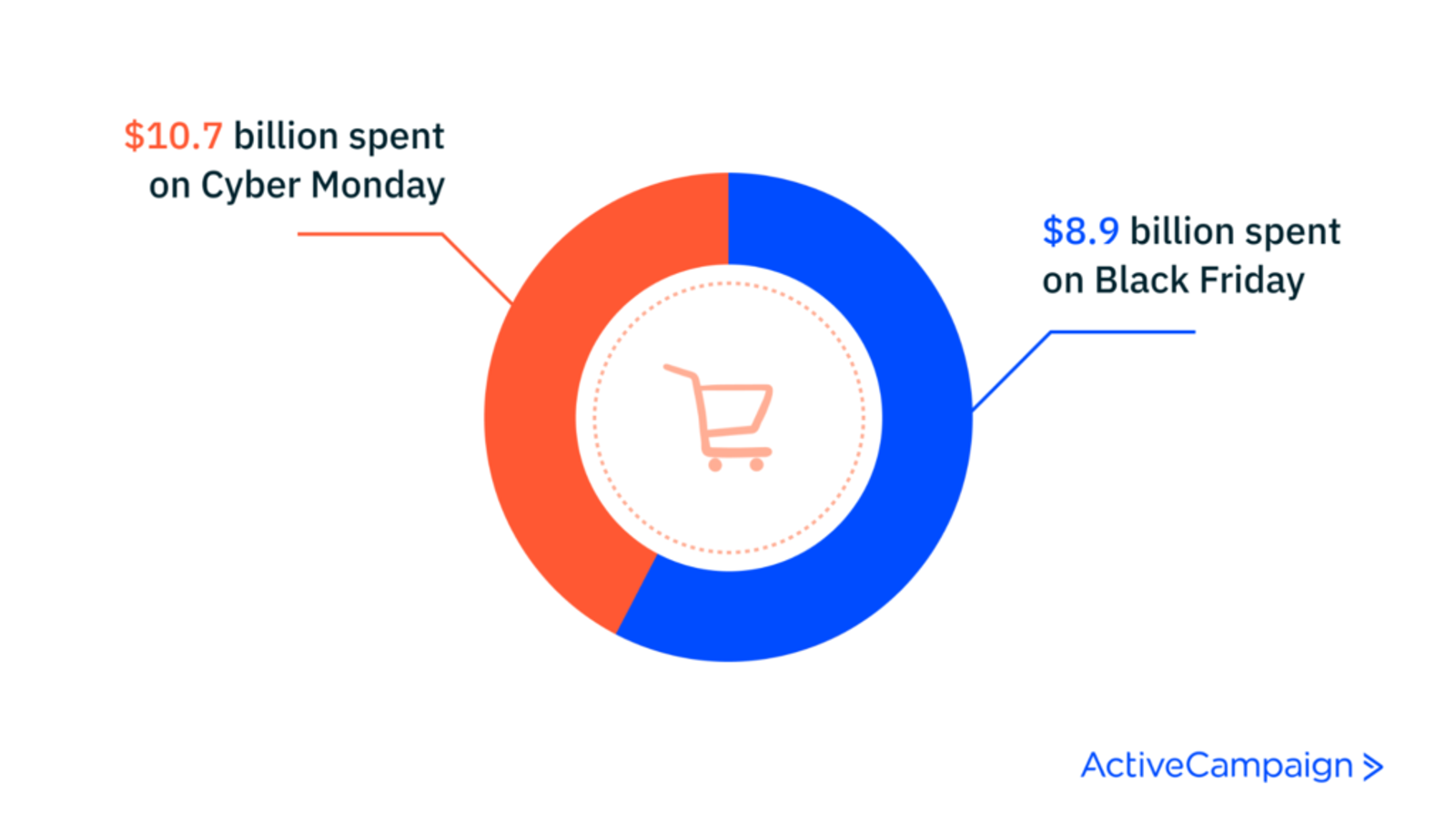
What this means: People tend to buy bigger-ticket items on Cyber Monday, which is good news for businesses. Try to change your marketing tactic and use Black Friday to warm up your audience, but introduce your most attractive deals on Cyber Monday.
Black Friday Fact 8: 61% of consumers trust influencers’ product recommendations
More than half of customers said influencers are more helpful and trustworthy than brands. Finally, 82% have either discovered or purchased a product after seeing it recommended by someone they trust. These two facts explain why big companies have doubled down on their influencer marketing.
What this means: Influencer marketing can help your sales get a boost—if you find niche opinion leaders your audience actually listens to. Creator campaigns are measurable, so you can quickly find out which creators bring you more leads and loyal customers.
How to reshape your Black Friday messaging for 2024 and beyond
Here are the key aspects you should consider when developing your Black Friday marketing.
- Above everything else, make sure that your brand is relatable and genuine. Today's customers have a low tolerance for manipulative selling and superficial communication.
- Find niche influencers who'll help reach your audience through their favorite channels.
- Identify and address your audience's urgent needs and help them reach their goals through better Black Friday deals.
- Analyze customer context and empathize with customers before you launch your sale. Try to understand why they shop the way they do and how you can improve their experience.
- Make your Black Friday marketing more impactful by using your messaging to appeal to your customers' emotional sides. Consider the sustainability aspect, and look for ways to give your sale a purpose other than to boost revenue.
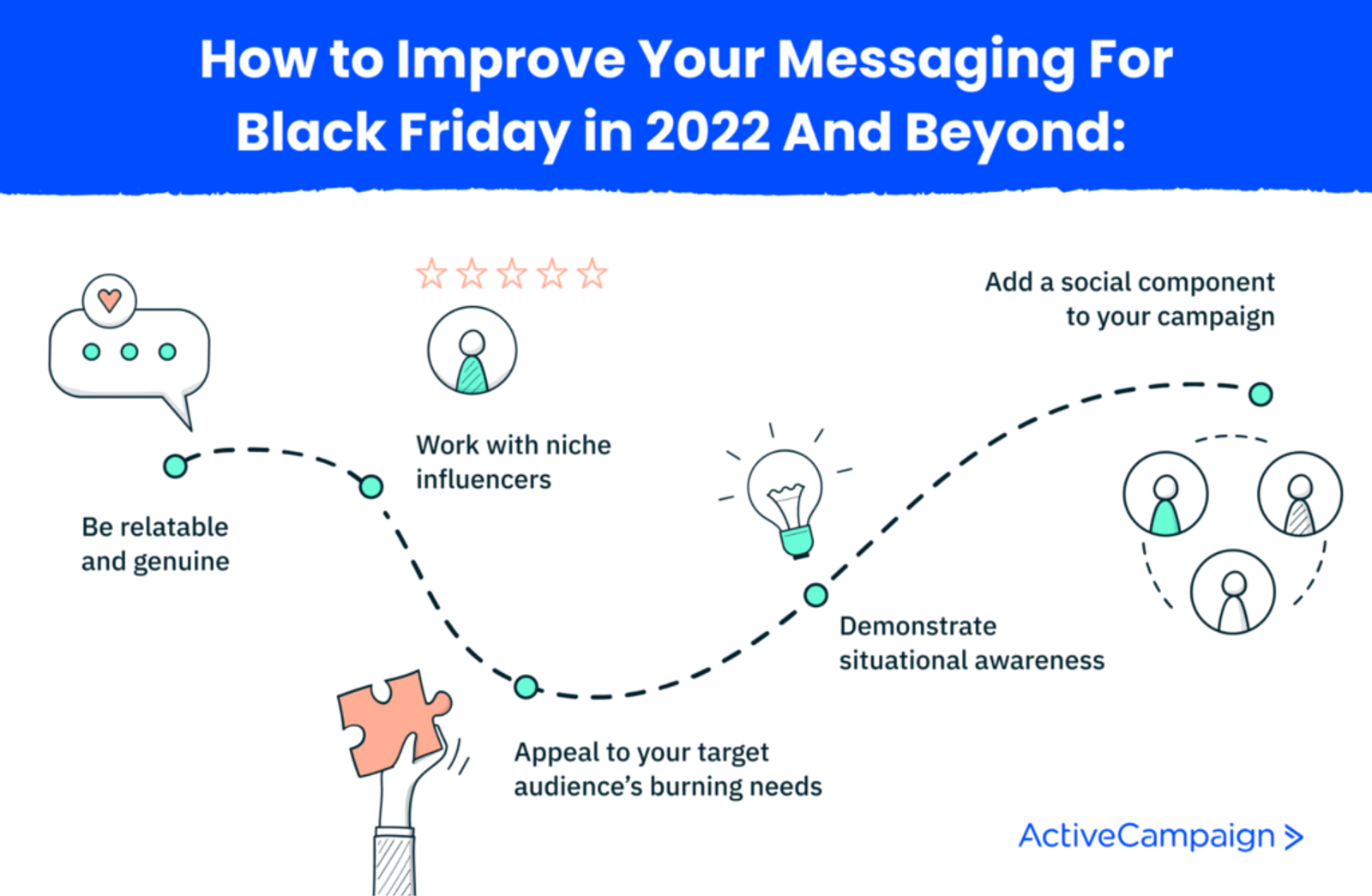
Now, let’s look back at what past Black Friday trends taught us.
Lessons learned from Black Friday history
It helps to remember what Black Friday looked like just a few years ago.
Discount-seekers would wake up early, ready to storm physical stores looking for the best deals. Some would even spend the night before in a tent waiting for the store to open. Overwhelmed retail employees, in turn, would try to tame the chaos or get out of the way and focus on restocking shelves as quickly as possible.
Every Black Friday sale resembled a battlefield. You might remember the viral videos with customers going berserk and grabbing more products than they could possibly carry or even need.
We rarely see that now.
Today's retailers focus on driving online sales, but only those that offer straightforward and smooth shopping experiences succeed. It's not enough to open your doors on Black Friday and expect your customers to fight over discounted items. Now, consumers expect businesses to fight over their attention and bombard them with more personalized offers and meaningful campaigns.
The main lesson here is that brands have to be flexible and attentive to the changing consumer landscape. No Black Friday sale is the same—each year's unique combination of societal and economic factors plays a huge role in how and when people spend money. Businesses must remain observant to spot and act on emerging tendencies and movements.
Make this Black Friday your most successful yet
Black Friday is a prime opportunity to connect with eager shoppers and boost your holiday revenue. Your business can cut through the noise and make a memorable impact by implementing effective marketing strategies, leveraging eye-catching creatives, and delivering targeted, personalized messages.
From the insights and examples above, you now have the tools to craft a Black Friday email marketing campaign that captures attention and drives conversions. Don’t leave it to chance—get a head start on your holiday marketing with ActiveCampaign. Our automation tools can help you plan, personalize, and optimize every email, ensuring your messages hit the mark.
Start your 14-day free trial with ActiveCampaign today and get ready to make this Black Friday your most profitable yet!
Frequently asked questions
How should I announce my Black Friday sales?
Announce your Black Friday sales across multiple channels to maximize reach and engagement. Use email marketing, social media posts, SMS messages, and targeted ads to reach different segments of your audience. Incorporate chatbots and website pop-ups to engage visitors as they browse your site. Remember to personalize your messaging based on customer behavior and past interactions. Create segmented lists to send only the most relevant offers, increasing the likelihood of conversions.
When should I start promoting Black Friday sales?
Begin your promotions early to build excitement. If you’re offering early deals, start emailing your list in late September or October, gradually increasing frequency as Black Friday approaches. The week before Black Friday is critical for last-minute reminders, and don't forget to keep the momentum going throughout Cyber Week, including Small Business Saturday and Cyber Monday. This approach helps keep your brand top-of-mind during the entire shopping period.
How many emails should I send on Black Friday?
On Black Friday, it’s common to send 2-3 targeted emails throughout the day—such as a morning announcement, an afternoon reminder, and an evening “last chance” message. However, test different strategies to see what works best for your audience. Be mindful of email fatigue; avoid overloading your subscribers, as too many emails can lead to unsubscribes. Monitoring your email open rates and engagement metrics will help you fine-tune the frequency.
What are some effective strategies for Black Friday subject lines?
Craft subject lines that grab attention with urgency, exclusivity, or curiosity. Use phrases like “Limited Time Only!” or “Biggest Deals of the Year” to spark interest. Consider using emojis to stand out in crowded inboxes, but keep it relevant to your brand. A/B test different subject lines to see which resonates most with your audience and adjust your approach based on those results.
How can I encourage customers to act quickly?
Create a sense of urgency by using countdown timers in your emails or highlighting “limited-time” offers. Promote “while supplies last” messages for popular products, and consider offering exclusive discounts for early buyers. These tactics can help drive immediate action and increase conversions during the competitive Black Friday period.

